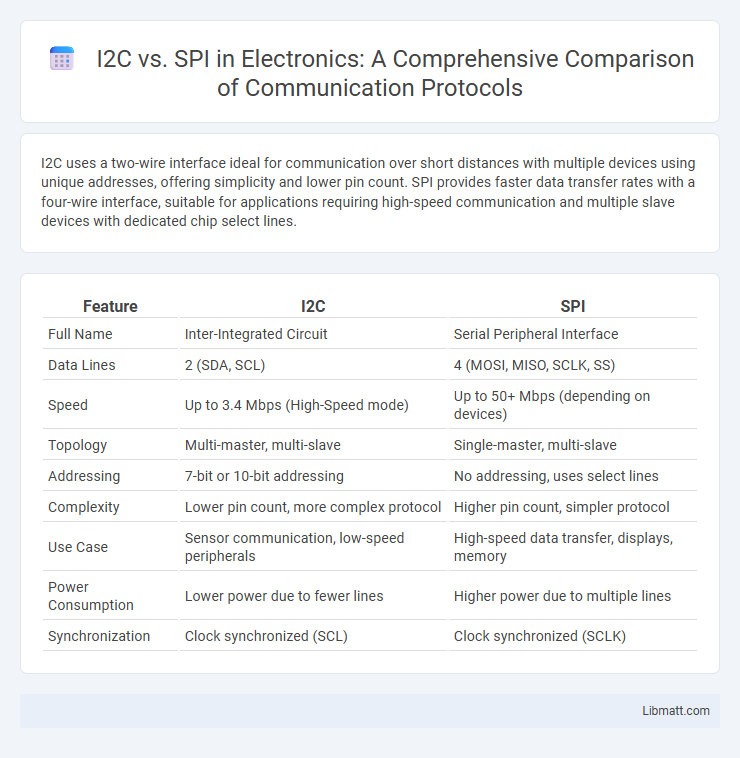I2C uses a two-wire interface ideal for communication over short distances with multiple devices using unique addresses, offering simplicity and lower pin count. SPI provides faster data transfer rates with a four-wire interface, suitable for applications requiring high-speed communication and multiple slave devices with dedicated chip select lines.
Table of Comparison
| Feature | I2C | SPI |
|---|---|---|
| Full Name | Inter-Integrated Circuit | Serial Peripheral Interface |
| Data Lines | 2 (SDA, SCL) | 4 (MOSI, MISO, SCLK, SS) |
| Speed | Up to 3.4 Mbps (High-Speed mode) | Up to 50+ Mbps (depending on devices) |
| Topology | Multi-master, multi-slave | Single-master, multi-slave |
| Addressing | 7-bit or 10-bit addressing | No addressing, uses select lines |
| Complexity | Lower pin count, more complex protocol | Higher pin count, simpler protocol |
| Use Case | Sensor communication, low-speed peripherals | High-speed data transfer, displays, memory |
| Power Consumption | Lower power due to fewer lines | Higher power due to multiple lines |
| Synchronization | Clock synchronized (SCL) | Clock synchronized (SCLK) |
Introduction to I2C and SPI
I2C (Inter-Integrated Circuit) and SPI (Serial Peripheral Interface) are two widely used communication protocols for connecting microcontrollers and peripherals. I2C uses a two-wire bus with a master-slave architecture, enabling multiple devices to share the same communication lines with unique addresses. SPI employs a full-duplex, four-wire bus system offering higher data transfer speeds but requires separate lines for each device, making it suitable for applications demanding fast and efficient data exchange.
Key Features of I2C Protocol
I2C protocol utilizes a two-wire interface comprising a serial data line (SDA) and a serial clock line (SCL) to facilitate communication between multiple slave devices and a single master. It supports multi-master configuration, enabling several master devices to control the bus, while each slave device has a unique 7-bit or 10-bit address for addressing. The I2C protocol offers synchronous data transfer, variable data rates up to 5 Mbps in High-Speed mode, and built-in acknowledgment mechanisms to ensure reliable communication across short-distance connections in embedded systems.
Key Features of SPI Protocol
SPI protocol features include full-duplex communication, enabling simultaneous data transmission and reception through separate data lines (MOSI and MISO). It operates with a master-slave architecture, utilizing a dedicated clock line (SCLK) for synchronous data transfer and individual chip select (CS) lines for device selection. High data transfer rates and simple hardware implementation make SPI suitable for applications requiring fast, reliable communication between microcontrollers and peripheral devices.
Communication Architecture: I2C vs SPI
I2C uses a multi-master, multi-slave, half-duplex communication architecture with two bidirectional lines, SDA (data) and SCL (clock), allowing multiple devices to share the same bus. SPI employs a full-duplex, master-slave architecture with separate lines for clock (SCLK), master output/slave input (MOSI), master input/slave output (MISO), and a dedicated chip select (CS) for each slave, enabling faster data transfer rates. Your choice between I2C and SPI depends on factors like wiring complexity, speed, and the number of devices in your communication network.
Data Transfer Speed Comparison
SPI offers higher data transfer speeds, typically ranging from 1 Mbps up to 50 Mbps or more, making it suitable for applications requiring rapid communication. I2C data rates are generally slower, with standard modes at 100 kbps, fast mode at 400 kbps, and high-speed mode reaching up to 3.4 Mbps. The full-duplex nature and simpler signaling in SPI enable faster throughput compared to the half-duplex, multi-master bus design of I2C.
Pin Configuration and Wiring Complexity
I2C uses two pins--SDA for data and SCL for clock--simplifying wiring and allowing multiple devices on the same bus with unique addresses. SPI requires at least four pins--MOSI, MISO, SCLK, and SS--resulting in more complex wiring, especially when connecting multiple devices, as each needs a dedicated slave select line. Your choice between I2C and SPI should consider the trade-off between simpler wiring and faster communication speeds.
Scalability: Devices and Addressing
I2C supports scalability by allowing multiple devices on the same bus with unique 7- or 10-bit addresses, enabling up to 128 or 1024 devices respectively, making it ideal for complex systems requiring numerous connections. SPI offers faster data rates but uses separate chip-select lines for each device, limiting scalability due to increased pin usage and wiring complexity. Your choice between I2C and SPI depends on the number of devices and addressing needs in your design.
Power Consumption and Reliability
I2C typically consumes less power due to its simpler two-wire interface and slower communication speeds, making it ideal for battery-powered devices. SPI offers higher reliability with faster data transfer rates and dedicated clock signals, reducing the risk of data corruption in noisy environments. Choosing between I2C and SPI depends on your device's power constraints and the need for reliable, high-speed communication.
Common Applications of I2C and SPI
I2C is commonly used in applications requiring simple, low-speed communication such as connecting sensors, EEPROMs, and real-time clocks within embedded systems. SPI is favored in high-speed data transfer scenarios like LCD displays, SD cards, and flash memory devices where fast, full-duplex communication is essential. Both protocols are prevalent in microcontroller interfacing, but I2C excels in multi-device bus environments while SPI provides superior speed and efficiency for point-to-point connections.
Choosing the Right Protocol: I2C or SPI
Choosing the right communication protocol between I2C and SPI depends on factors like data transfer speed, complexity, and device count. I2C supports multiple devices with only two wires and is ideal for low-speed, short-distance communication in embedded systems. SPI offers higher data rates and full-duplex communication, making it suitable for applications requiring fast data transfer and higher bandwidth.
I2C vs SPI Infographic

 libmatt.com
libmatt.com